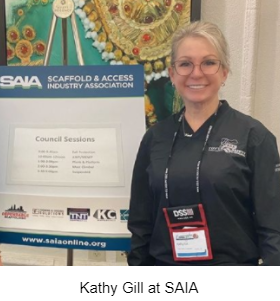While most towercos and carriers train for potential rescues from towers, the increase in usage of mobile platforms (MEWPS) has increased dramatically, particularly for monopoles, water tanks and lower level tower work. Unfortunately, accidents involving those assets have been on the increase as well, according to Tower Safety CEO Kathy Gill, who recently attended a Scaffold & Access Industry Association (SAIA) meeting in Florida. At the conference, Gill was inducted into SAIA as the first telecom member in 49 years to participate in setting the ANSI 92 standards for MEWPS.
“There is much to learn from them and to help our wireless industry,” Gill said. “Rescues can vary in all industries with mobile elevating work platforms (MEWPs), cell towers, confined space, water tanks, vehicles, scaffolds and cranes.”
Gill said a rescue from a MEWP occurs often and the ANSI 92.24 standards requires a rescue plan prior to lifting, citing various manufacturers that offer self-rescue equipment. “That should be a part of that plan,” she said, “with the understanding that a 6-foot lanyard is no longer acceptable. The new accepted free fall distance is 2.5 feet with an adjustable lanyard.”
According to the Occupational Safety and Health Administration (OSHA), of the top ten categories most frequently cited in standards violations, fourth on the list is scaffolding. The standards have changed over the years for MEWPS, with ANSI issuing new regulations in 2018, requiring everyone to be trained in relevant rescue techniques.
Every organization that operates MEWPs needs to develop a safe use plan and having documented rescue plans is a requirement. OSHA regulations dictate the following:
- ANSI 92.24 Training requirements from a MEWP require performance of recovery maneuvers and rescue maneuvers from the ground position.
Gill said various manufacturers offer rescue kits and recommends the Buckingham 301SRK/301SRKQ2 or the Sterling Rope PDQ, both available at AHS Rescue. Tower Safety has produced a video on using the PDQ kit.
“Athletes practice repeatedly to achieve success and perfect their skills,” Gill said. “It means training and practicing. It means the right mindset for a moment that requires quick thinking, perhaps quick reactions, and trusting your instincts and gear.”





Reader Interactions